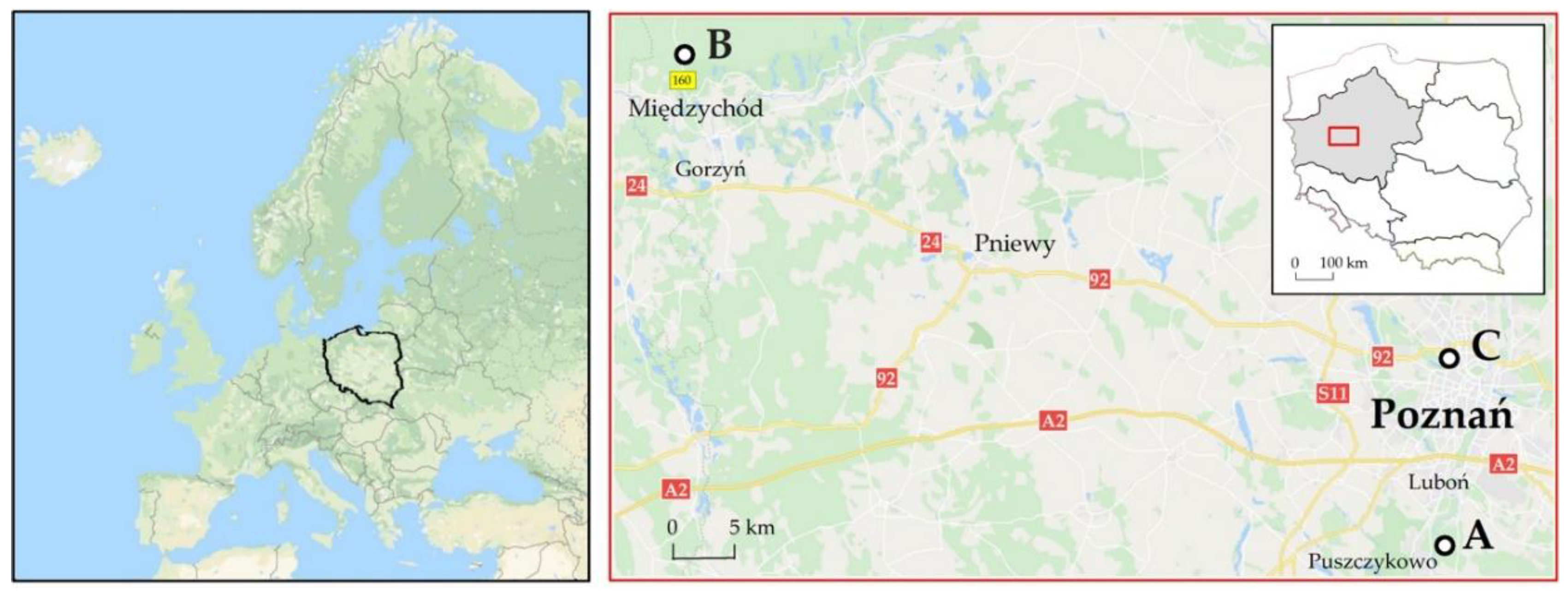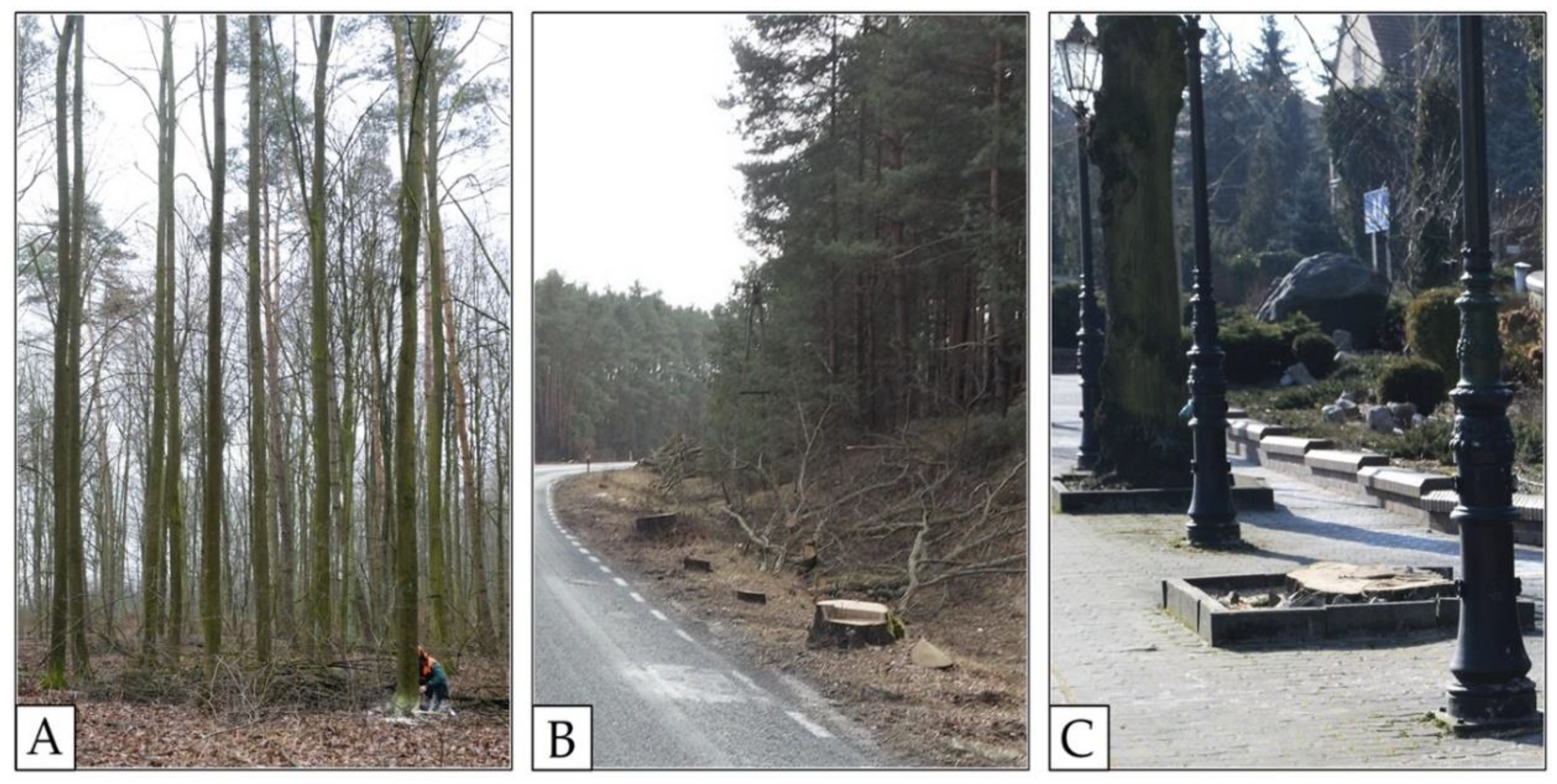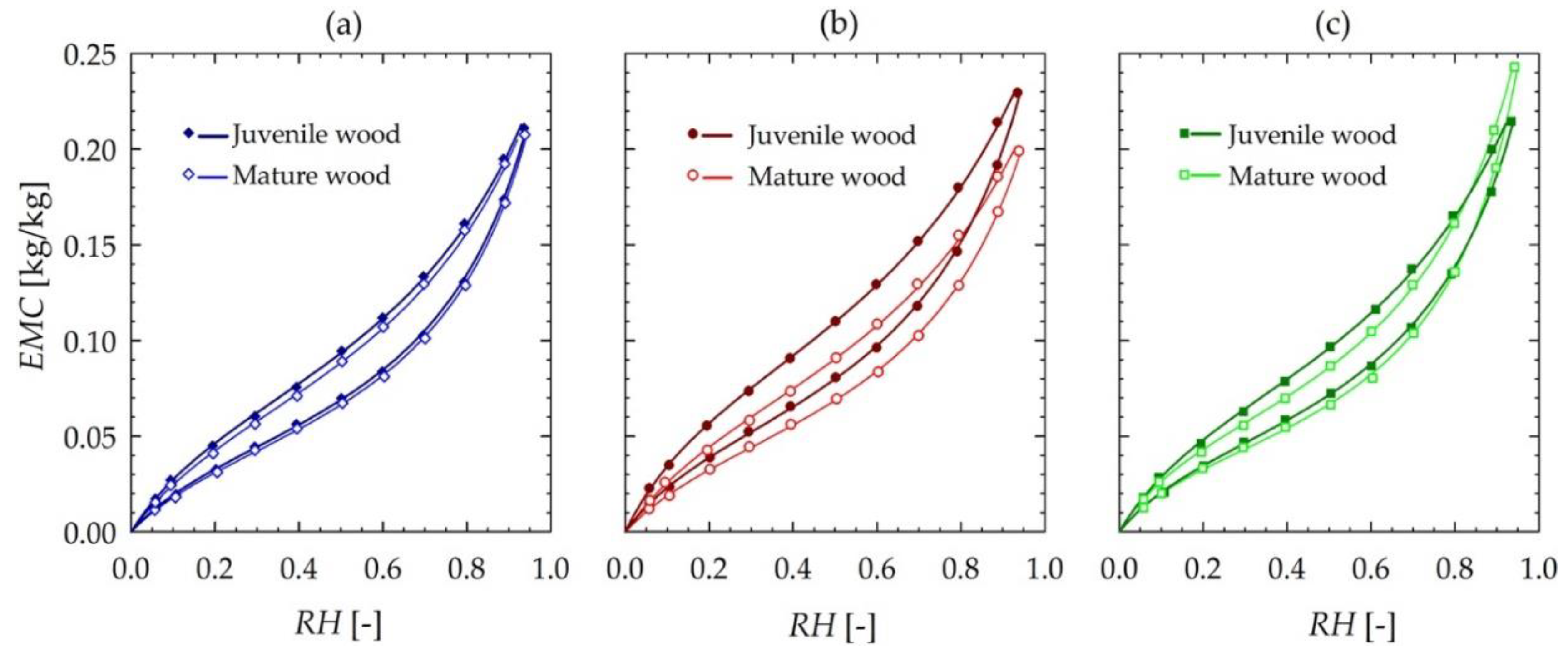3.2.1. Chemical Composition of Wood
In the range of wood chemical composition percentage content analysis, main components i.e., holocellulose, cellulose, pentosanes and lignin as well as components soluble in 1% NaOH and in ethanol were determined.
Table 1 presents the results of a multifactor variation analysis (two-factor ANOVA) for the investigated chemical composition. The analysis results indicate the significance of an environmental impact on content of each of the presented components (for
p < 0.05). Additionally, cambial age is a factor influencing substantially the investigated wood chemical composition excluding pentosanes and substances soluble in NaOH (
p > 0.05). A factor interaction (a × b) was also stated in every case, excluding pentosane content.
Table 2 shows the content of the investigated wood chemical components. As far as the juvenile wood is concerned, the total carbohydrate content (holocellulose) ranged from 75.7% to 85.8%. The juvenile wood from the tree growing under moderate environmental stress i.e., by the roadside (B) was characterised by the lowest holocellulose content. At the same time, statistically significant differences (α = 0.05) of mean holocellulose content in a tissue of the compared trees were stated. Slightly higher holocellulose content was determined for the mature wood of the investigated trees. In the case described, the content varied from 85.8% to 86.6%. There were no statistically significant differences in average holocellulose content in the mature wood. Cellulose content in the juvenile wood ranged from 42.8% to 44.6%. The most cellulose amount was determined for the tree wood growing by the roadside (B), whereas for the mature wood cellulose content ranged more widely from 41.6% to 46.7%. The highest cellulose content was determined for the tree growing under the lowest environmental conditions, i.e., in the forest (A), and the lowest for the tree growing under the highest environmental stress, i.e., the urban agglomeration (C). According to literature data [
47], content of that component in lime wood ranges from 43.2% to 54.0%, therefore the determined content does not diverge significantly from it. The content of pentosanes, major hemicellulose components of biomass, varied in the investigated tree’s juvenile wood from 20.5% to 24.5%. Considering literature data i.e., 19.7–20.4% [
47], the determined percentage content is slightly higher. For the mature wood, pentosane content was at an even higher level i.e., 23.0–23.9% and did not display difference significance.
Lignin content in the juvenile wood of the compared trees ranged from 20.2% to 22.1%. Difference significance was reported merely for the results for the tree growing under moderate environmental stress i.e., by the roadside (B). In the mature wood, lignin percent content was lower than in the juvenile wood and ranged from 17.9% to 20.1%. Difference significance was determined also only for the results obtained for the tree growing by the roadside (B). For the wood, both in the juvenile and mature area, the largest amount of lignin was determined. However, all the values obtained for the researched trees are at a low level comparing with literature data [
47].
Holocellulose to lignin content ratio (H/L) is an absolute value which gives a possibility to estimate numerical relationships between carbohydrate components and lignin. Lower values were determined for the juvenile wood and higher ones for the mature wood, which means that carbohydrate content in proportion to lignin in the juvenile wood is lower, whereas in the mature wood it is higher. For the tree growing by the roadside (B), both the juvenile and mature, the coefficient was the lowest.
The substances soluble in NaOH and EtOH were determined from the group of soluble components. The substances soluble in NaOH are wood components such as hemicelluloses, low-polymerised lignin, amorphous cellulose, fats as well as waxes. For the juvenile wood, their content ranged from 24.4% to 26.8%. In the mature wood, it changed in the wider range: from 20.0% to 33.4%. The majority of components from the group were determined in the wood from the tree growing under the highest environmental stress, i.e., the urban agglomeration (C), whereas the smallest number under the lowest environmental stress, were in the forest (A). The substances soluble in EtOH are the components from the group of lipid compounds, i.e., mainly resins, fats, waxes and others. Their content in the juvenile wood ranged from 3.3% to 9.3%, whereas in the mature wood this was slightly higher and varied from 5.4 to 14.0%. The highest compound group content, similar to the compounds soluble in 1% NaOH, was determined in the both wood areas from the tree growing in the urban agglomeration (C). Compared with literature data [
47], it is clear that percentage content of the both analysed groups of chemical components in lime wood growing in the urban agglomeration exceeds it greatly.
The results obtained for the juvenile and mature wood revealed that they showed similar reactions involving increasing or decreasing biosynthesis intensity of selected chemical components depending on the volume of environmental stress. It was observed that in both the juvenile and mature wood of the trees growing in the urban agglomeration (C), i.e., under high stress conditions, there was the least cellulose and lignin and the most substances soluble in NaOH and EtOH compared with the remaining trees. It can be concluded that despite the juvenile and mature wood being developed in various tree growth periods and differing in anatomy [
48,
49,
50], they demonstrated a similar response to environmental stress.
3.2.2. Chemical Elements of Wood
Table 3 presents the results of the two-factor ANOVA for the investigated groups of the elements’ chemical composition i.e., Fe, Zn, Cu, Pb, Cd, respectively. The analysis results indicate the significant effect of both included factors, i.e., cambial age and environment on the content of each of the included components (for
p < 0.05). Also stated are statistically significant interactions of factors (a × b) for all the analysed cases of the investigated chemical composition in lime wood.
The content of the selected heavy metals (
Table 4) determined in the juvenile and mature wood changed to a very high extent. The differences of the obtained results were statistically significant. In the juvenile wood, the highest value of iron (75.4 mg/kg) was determined for the tree growing in the urban agglomeration, i.e., under the highest environmental conditions (C). In the juvenile wood of the trees growing in two remaining locations with lower environmental stress, in the forest (A) and by the roadside (B), iron was determined at the level of 51.2 and 36.4 mg/kg, respectively.
The highest content of zinc and copper was determined in the mature wood of the tree growing in the urban agglomeration, i.e., under the highest environmental stress conditions (C). In the wood, the least cellulose and lignin but the most soluble substances were determined (see
Table 2). The mature wood of the tree growing in the forest, i.e., under the lowest environmental stress (A), contained the lowest content of zinc, copper, lead and cadmium yet the most cellulose (see
Table 2). The results of higher content of heavy metals in the wood stemming from the trees from more polluted areas were also mentioned in the article by Krutul et al. [
15]. The authors investigating oak wood, obtained from an unpolluted area, determined a lack or trace amounts of lead. Moreover, according to Watmough et al. [
51,
52], lead content in sugar maple wood (
Acer saccharum Marshall) ranged from 0.5 to 1.5 mg/kg. The lead concentration results at 0 level presented in this article and determined in the mature lime wood from the tree growing in the forest (A) confirm that as well. To compare, cadmium content in oak (
Quercus petraea Liebl.) wood from a non-polluted environment was from 0.02, 0.01 and 0.15 mg/kg in the sapwood, heartwood and bark, respectively [
14]. In the presented research, cadmium was determined at a distinctly higher level in the mature wood growing under the highest or moderate environmental stress, i.e., in the urban agglomeration (C) 0.3 mg/kg and by the roadside (B) 1.4 mg/kg, respectively. The lowest zinc and cadmium content, as in the mature wood, was determined in the juvenile wood growing under the lowest environmental stress (A), i.e., in the forest (Zn: 23.7 mg/kg and Cd: 0.1 mg/kg).
Table 5 presents the two-factor ANOVA results for the investigated chemical composition groups of elements i.e., K, Ca, Na, Mg, respectively. The analysis results show a substantial influence of both included factors, i.e., cambial age and environment on the content of each of the included components (for
p < 0.05). The statistically significant interactions of factors (a × b) for all the analysed cases of the investigated chemical composition in
Tilia cordata Mill. wood also occurred.
The potassium, sodium, magnesium and calcium content (
Table 6) in the juvenile and mature wood changed to a high extent and differences between the results were statistically significant. In the juvenile wood, the highest potassium, sodium and calcium concentration was determined in the tree by the roadside (B), for which environmental stress was moderate (K: 3376.3 mg/kg, Na: 3186.6 mg/kg and Ca: 9732.2 mg/kg). However, the biggest amount of magnesium was determined in the juvenile tree wood growing in the forest, i.e., in the area with the lowest environmental stress (A) (Mg: 1446.8 mg/kg). The lowest concentration of elements was determined in the juvenile wood of the tree growing in the urban agglomeration, i.e., under the highest environmental conditions (C) (K: 410.6 mg/kg, Na: 1814.3 mg/kg, Mg: 536.0 mg/kg, Ca: 5100.9 mg/kg). It is worth noticing that for the mature tree wood growing under those conditions (i.e., C), the highest volume of potassium, sodium, magnesium and calcium was determined (K: 3337.6 mg/kg, Na: 3400.0 mg/kg, Mg: 898.5 mg/kg, Ca: 3189.8mg/kg), whereas the lowest content of elements, excluding magnesium, for the mature wood was determined for the tree growing under the lowest environmental stress (A), i.e., in the forest (K: 1307.7 mg/kg, Na: 1161.9 mg/kg, Ca: 1902.7 mg/kg).
For the mature wood from the urban agglomeration, i.e., growing under the highest environmental stress (C), in which the highest potassium, sodium, magnesium and calcium content was determined, there was the lowest content of cellulose and lignin and the largest number of soluble substances (
Table 2). However, in the mature wood from the least polluted area (A), i.e., from the forest, with the lowest content of potassium, sodium and calcium, the highest content of cellulose and the lowest content of soluble substances was determined (see
Table 2).
In our research, relationships between very high potassium and calcium content and heavy metal content e.g., zinc, cadmium and copper were noticed. In the wood of the tree growing in more polluted areas (C and B) in which potassium and calcium were determined at a very high level (mature wood K: 3337.6 mg/kg, Ca: 3189.8 mg/kg; juvenile wood K: 3376.3, Ca: 9732.2 mg/kg), zinc, copper and cadmium were also determined in the highest concentration (mature wood Zn: 78.6 mg/kg, Cu: 26.3 mg/kg; juvenile wood Zn: 33.5, Cd: 0.5 mg/kg). Moreover, relationships between very high calcium concentration and very low iron content can be reported for the juvenile wood of the tree growing by the roadside (B). The reported relationships between calcium and iron can also be observed in the mature wood of the tree growing in the area of the lowest stress, i.e., the forest (A). In the wood, calcium was determined at the lowest level, which corresponded with the highest iron content. Such high iron concentration compared with low calcium concentration confirms the results presented by Krutul et al. [
15] who proved that plants accumulate iron when soil pH is low. When soil contains a huge amount of calcium, iron transforms into a form inaccessible to plants and it is not accumulated by them.













